Don't wanna be here? Send us removal request.
Text

From Local Roots to National Reach: Crafting Sustainable Brands Through Digital Strategy
Sustainable brand growth today requires more than simply being seen—it requires being remembered. A brand must not only stand out but stand for something. Transitioning from a local business to a nationally recognized brand is not just an expansion—it’s a transformation. And digital strategy is the bridge that makes this evolution possible.
Local brands typically begin with deep community ties, heartfelt storytelling, and a sense of personal connection. These are strengths, not limitations. But to scale without dilution, a thoughtful digital framework must preserve that authenticity while introducing strategic structure. This means creating a unified voice across platforms, utilizing SEO and paid media to amplify reach, and designing seamless customer journeys online.
A digital strategy is not static—it evolves as the brand grows. It draws from real-time analytics, market behavior, and cultural trends. It balances brand storytelling with performance marketing. It ensures that every asset—social content, email outreach, ad copy—reinforces brand trust while reaching new audiences.
Digital marketing experts play a critical role in this process. They translate brand essence into scalable campaigns. They guide businesses from being a neighborhood favorite to becoming a national name—without losing what made them special.
Because sustainable growth isn’t about chasing scale. It’s about expanding with purpose, connecting with clarity, and scaling without compromise.
#digital marketing#i love them smmmm#media marketing#seo company#smm panel#smm#smm2#smmagency#smmarketing#social marketing
0 notes
Text
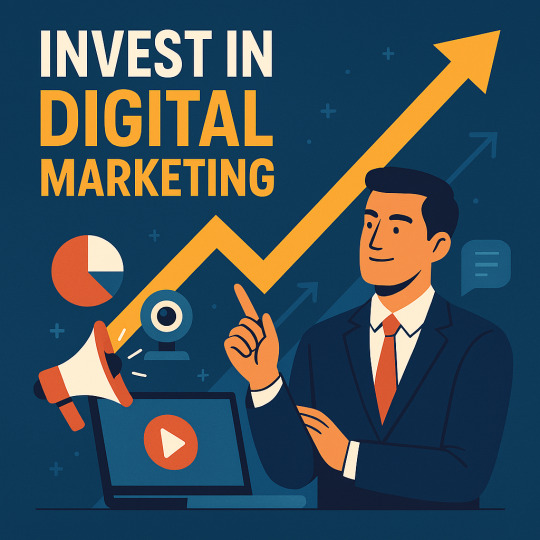
Digital Marketing for Public Institutions: A Strategic Imperative in the Information Era
Public institutions—whether in governance or education—operate in a rapidly evolving digital environment. Their ability to communicate effectively, build trust, and drive social progress increasingly depends on their digital presence. In this context, investing in digital marketing is not just relevant—it is critical.
Modern citizens and students are digital-first. They seek information online, form opinions through social media, and expect quick, clear communication. For institutions, meeting this expectation means developing structured digital strategies that inform, inspire, and interact.
Educational organizations can extend their influence by promoting academic programs, research achievements, and community initiatives through digital campaigns. This visibility helps attract partnerships, funding, and global talent—factors that directly support long-term growth and innovation.
Government bodies benefit from transparent communication, particularly in times of uncertainty. Well-executed digital outreach can clarify public policy, strengthen community trust, and combat harmful misinformation.
In an era where digital narratives shape public opinion, silence is a risk. Institutions that invest in strategic digital marketing are not only adapting—they are leading. They ensure their values, mission, and knowledge reach the people they serve, where they are: online.
0 notes
Text

AI in Digital Marketing: Automation, Analytics, and Ethical Impact
Artificial Intelligence (AI) is no longer a vision of the future — it’s an active, transformative force revolutionizing the field of digital marketing. For small and medium-sized businesses (SMBs), AI is more than just a technological tool; it’s a growth engine that drives operational efficiency, lowers costs, and accelerates scalability.
AI-powered automation streamlines time-consuming tasks such as content scheduling, personalized email campaigns, and ad targeting. By automating these processes, marketers can redirect their focus to high-level strategic planning and creative innovation. At the same time, advanced AI analytics deliver deep, real-time insights into customer behavior, empowering data-driven decisions that enhance ROI and foster long-term customer loyalty.
One of AI’s most powerful attributes is its adaptability. With the help of machine learning, AI systems constantly analyze campaign performance and refine strategies in real time. This ongoing optimization enables businesses to scale rapidly while maintaining a personalized and meaningful connection with their audience.
Yet, with innovation comes responsibility. The widespread use of AI in marketing introduces ethical concerns — particularly around data privacy, algorithmic bias, and transparency. Brands that embrace ethical AI practices will stand out as trustworthy, future-ready leaders in a crowded digital marketplace.
Ultimately, when used thoughtfully and responsibly, AI doesn’t just make marketing smarter — it helps shape a more intelligent, inclusive, and sustainable business future.
#digital marketing#i love them smmmm#media marketing#seo company#smm#smm panel#smm2#smmagency#smmarketing#social marketing
0 notes
Text
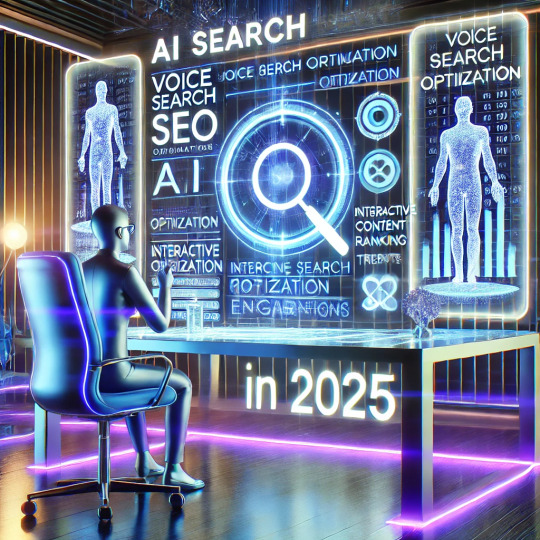
How to Rank #1 on Google in 2025: Cutting-Edge SEO Strategies
SEO in 2025 is more competitive than ever, with AI-driven search algorithms, evolving user behavior, and Google’s increasing emphasis on experience. To dominate the rankings, follow these key strategies:
1. AI-Powered Content Optimization
Google’s AI, like Search Generative Experience (SGE), prioritizes content that directly answers user intent. Leverage AI-assisted tools to refine keyword strategy, structure content for featured snippets, and maintain high relevance.
2. Enhanced EEAT (Experience, Expertise, Authority, Trust)
Websites with strong author credibility, real-world experience, and authoritative backlinks gain an edge. Publishing case studies, expert interviews, and verified information builds trust.
3. Voice & Visual Search Optimization
More searches happen via voice and images. Use conversational long-tail keywords, structured data, and image SEO (ALT text, compression, AI tagging) to increase visibility.
4. Mobile-First UX & Core Web Vitals
Google prioritizes fast, mobile-friendly sites. Improve loading speed, interactive design, and navigation to boost rankings.
5. Hyper-Personalized & Interactive Content
Search engines favor engaging formats like AI-powered chat, interactive videos, and personalized recommendations. Focus on user retention and value-driven experiences.
6. Local SEO & AI-Powered Search Features
Local businesses must optimize Google Business Profiles, use geotargeted keywords, and leverage AI-driven search enhancements for visibility.
Staying ahead in 2025 means embracing AI, user experience, and adaptability. SEO isn’t just about rankings—it’s about delivering the best possible experience.
#SEO2025 #GoogleRanking #AISEO #ContentStrategy #DigitalMarketing #LocalSEO #SearchOptimization
#digital marketing#i love them smmmm#media marketing#seo company#smm#smm panel#smm2#smmagency#smmarketing#social marketing
0 notes
Text

The Role of AI in SEO: How Artificial Intelligence is Transforming Website Optimization
The landscape of Search Engine Optimization (SEO) is evolving rapidly, and Artificial Intelligence (AI) is at the forefront of this transformation. Traditional SEO relied heavily on manual keyword research, backlink building, and content optimization, but AI has introduced automation, predictive analysis, and real-time data-driven decisions, changing the game entirely.
1. Smarter Keyword Research & Content Optimization
AI-powered tools like ChatGPT, SurferSEO, and Clearscope analyze search trends and user intent, suggesting high-impact keywords and content structures that align with Google’s ranking algorithms. This means marketers can create highly relevant, user-focused content faster than ever before.
2. AI-Driven SEO Automation
From automated metadata generation to real-time SEO audits, AI simplifies complex SEO tasks. Platforms like RankBrain and BERT analyze search queries more intelligently, ensuring that websites offering the most relevant, natural-language content rank higher.
3. Personalization & UX Optimization
Google prioritizes user experience (UX), and AI helps personalize website content based on user behavior. Features like chatbots, AI-generated recommendations, and adaptive site layouts enhance engagement, reducing bounce rates and increasing conversions.
4. AI in Technical SEO & Site Performance
AI detects broken links, crawl issues, site speed problems, and mobile responsiveness in real time, ensuring seamless technical SEO management. Automated tools like Google’s Lighthouse and Screaming Frog help businesses stay ahead of algorithm updates.
Conclusion: AI is the Future of SEO
The days of guesswork and manual adjustments are fading. AI-driven SEO enables businesses to analyze vast datasets, predict trends, and automate tedious tasks, making optimization more efficient and effective. Staying ahead in SEO now means embracing AI-powered insights and automation for sustainable digital success.
#AISEO #SEOtrends #AIoptimization #DigitalMarketing #SearchEngineOptimization #AIforSEO #MarketingAutomation
0 notes
Text

How to Write Blog Posts That Rank High and Convert Readers into Customers
A well-crafted blog post is more than just words—it’s a powerful tool for SEO success and customer conversion. If your content doesn’t rank or drive sales, you’re missing out on significant opportunities. Follow these steps to create blog posts that attract traffic and turn visitors into loyal customers.
1. Find High-Intent Keywords
Start with thorough keyword research. Focus on phrases that align with what your audience is actively searching for. Tools like Google Keyword Planner, SEMrush, and Ahrefs can help you find keywords with high search volume and low competition.
2. Craft an Engaging and SEO-Optimized Title
Your title should be clear, compelling, and include your target keyword. The best headlines:
✔ Spark curiosity
✔ Offer a solution
✔ Use numbers or power words (e.g., “Proven,” “Ultimate,” “Step-by-Step”)
Example: “10 Proven Blogging Techniques to Rank Higher and Boost Sales”
3. Structure Your Content for Readability and SEO
To keep both readers and search engines happy, format your blog post with:
• Short paragraphs (2-3 sentences max)
• Subheadings (H2, H3) for clarity
• Bullet points and numbered lists
• Internal and external links for credibility
4. Deliver Value and Solve Real Problems
Readers engage with content that helps them solve a problem or achieve a goal. Use:
• Actionable advice instead of vague tips
• Real-world examples and case studies
• Visuals (images, infographics, videos) to enhance understanding
5. Optimize for On-Page SEO
To increase your chances of ranking on Google:
✅ Place your main keyword in the title, first 100 words, and URL
✅ Use meta descriptions (150-160 characters with keywords)
✅ Add alt text to images
✅ Speed up your site’s loading time
6. Include a Clear Call-to-Action (CTA)
A blog post should lead readers to take action. Whether it’s signing up for a newsletter, downloading a guide, or making a purchase, your CTA should be:
➡ Clear and direct (“Get Your Free eBook Now”)
➡ Visually distinct (buttons, highlighted text)
➡ Placed strategically (beginning, middle, and end of the post)
7. Promote and Repurpose Your Content
Creating a great post isn’t enough—you need to distribute it effectively.
✔ Share it on social media platforms
✔ Repurpose it into a video, infographic, or podcast
✔ Engage in guest blogging and backlink building
Final Thoughts
A successful blog post ranks well on search engines and converts visitors into paying customers. By combining SEO techniques, engaging writing, and strong CTAs, you’ll create content that drives both traffic and sales.
🚀 Start implementing these strategies today and watch your blog’s impact grow!
#SEO #ContentMarketing #BloggingTips #DigitalMarketing #MarketingStrategy #SEOforBusiness
0 notes
Text
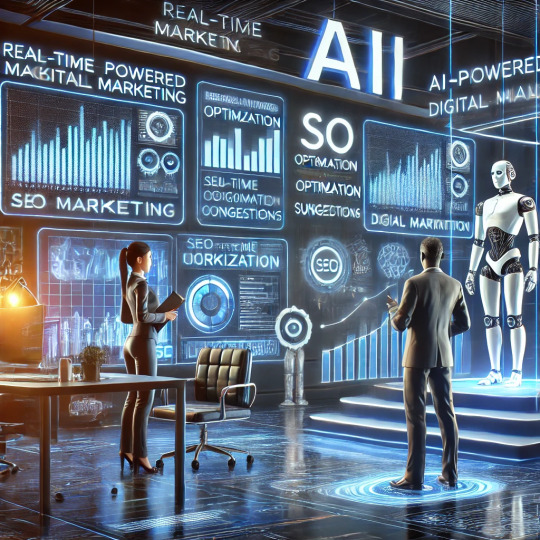
The AI Revolution in Digital Marketing: Transforming the Future
Artificial Intelligence (AI) is revolutionizing digital marketing, making it smarter, more efficient, and highly personalized. With the rapid evolution of machine learning and automation, businesses are leveraging AI to enhance customer engagement, optimize campaigns, and maximize ROI.
One of the most transformative aspects of AI in marketing is predictive analytics. AI can analyze massive datasets in real time, identifying trends, customer behaviors, and potential market shifts. This allows brands to make data-driven decisions, ensuring their strategies are always ahead of the curve.
AI-driven automation is also streamlining marketing efforts. From chatbots that provide instant customer support to AI-powered email campaigns that adapt to user preferences, businesses are saving time while improving user experiences. Additionally, AI tools help with SEO optimization, identifying the best keywords, improving content relevance, and enhancing website performance.
Social media marketing has also seen a significant boost through AI. Advanced algorithms analyze user engagement, allowing brands to create highly targeted ads that resonate with the right audience. AI-generated content, such as personalized recommendations and automated posts, ensures consistent and engaging online presence.
As AI technology continues to evolve, digital marketing will become even more refined, predictive, and customer-centric. Businesses that embrace AI-driven strategies will not only stay competitive but also redefine how brands connect with their audience.
#AI #DigitalMarketing #MarketingTrends #Automation #SEO #SMM #AIinMarketing #MarketingInnovation #FutureOfMarketing
0 notes
Text
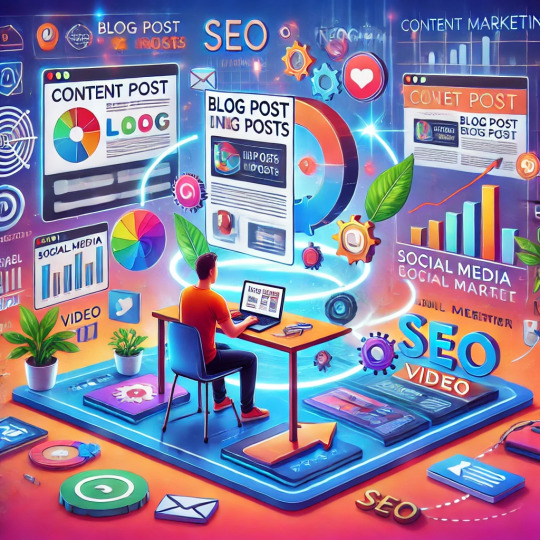
Maximizing SEO and Social Media Success by Repurposing Old Blog Posts
Your old blog posts are a hidden goldmine for boosting SEO and social media engagement. Instead of letting them collect digital dust, transform them into fresh, engaging content that reaches new audiences and strengthens your online presence. Here’s how:
1. Refresh and Optimize for SEO
Old posts can lose relevance over time. Update outdated data, broken links, and keywords to align with current search trends. Improve readability, add new internal links, and enhance meta descriptions for better ranking potential.
2. Convert Into Visual Content
People love visual storytelling. Summarize key blog points into infographics, quote graphics, or carousel posts for Instagram and LinkedIn. This makes your content more shareable and digestible.
3. Create Short-Form Social Media Posts
Break down long-form content into bite-sized insights for Twitter, Facebook, and TikTok. Turn statistics into tweets, key takeaways into LinkedIn posts, or summarize entire articles in engaging Instagram captions.
4. Transform Blogs into Videos or Podcasts
Repurpose written content into engaging video scripts for YouTube, Reels, or TikToks. If you prefer audio, discuss key topics in a podcast episode to reach audiences who consume content on the go.
5. Compile into an eBook or Email Series
Group similar blog posts into an insightful eBook or turn them into a valuable email series for your subscribers. This builds authority and nurtures your audience with consistent content.
6. Republish on Different Platforms
Expand your reach by reformatting and sharing your updated blog posts on platforms like Medium, LinkedIn Articles, or industry-specific forums. Adjust the style to fit each audience while maintaining SEO-friendly structures.
By repurposing old blog content strategically, you extend its lifespan, boost website traffic, and enhance brand visibility across multiple channels. Don’t let great content go to waste—revive, reinvent, and re-engage!
#ContentRepurposing #SEOBoost #SocialMediaMarketing #DigitalStrategy #ContentCreation
0 notes
Text

Long-Form vs. Short-Form Content: What Works Best in 2025?
In the digital marketing world, content length is a critical factor in engaging audiences and improving search rankings. As we step into 2025, businesses must understand the differences between long-form and short-form content and how to leverage them effectively. Which format works best? The answer lies in your audience, platform, and marketing goals.
The Power of Short-Form Content
Short-form content includes social media posts, short blog articles, infographics, TikTok videos, and Reels—typically under 1,000 words or 60 seconds.
🔹 Why It Works in 2025
✅ Fast Consumption: Audiences crave quick, digestible content for instant engagement.
✅ Social Media-Friendly: Short videos and posts dominate TikTok, Instagram, and LinkedIn.
✅ Higher Shareability: Bite-sized content is easier to share and go viral.
⚠️ Limitations
• SEO potential is limited—shorter blogs may rank lower.
• Lacks depth—harder to establish expertise in a short format.
Why Long-Form Content Still Reigns
Long-form content includes in-depth blog posts (1,500+ words), eBooks, podcasts, and whitepapers.
🔹 Why It Works in 2025
✅ SEO & Authority Boost: Google favors detailed, well-researched articles.
✅ Higher Engagement & Conversions: Readers spend more time on valuable, insightful content.
✅ Evergreen Impact: Quality long-form content stays relevant for years.
⚠️ Limitations
• Takes more time & resources to produce.
• Lower shareability on fast-moving social platforms.
What’s the Best Strategy?
📌 Hybrid Approach Wins in 2025:
✅ Use short-form content for social media engagement and brand awareness.
✅ Repurpose long-form content into shorter snippets for different platforms.
✅ Leverage long-form content for SEO, thought leadership, and conversions.
🚀 The best strategy in 2025 is to balance both formats based on platform, audience, and business goals.
#ContentMarketing #SEO2025 #MarketingTrends #ShortFormVsLongForm #DigitalMarketing
0 notes
Text

Maximizing Social Media on a Budget: A Startup’s Guide
Social media is a game-changer for startups, but limited budgets can make it challenging to compete with big brands. Fortunately, a well-planned strategy can help you maximize reach without overspending. Here’s how startups can use social media effectively while keeping costs low.
1. Focus on the Right Platforms
Instead of spreading thin across all platforms, concentrate on the ones where your target audience is most active. For B2B startups, LinkedIn is ideal, while Instagram and TikTok work best for visually-driven brands.
2. Create High-Quality Content for Free
Leverage free tools like Canva for graphics, CapCut for videos, and Unsplash for stock photos. Short-form videos, infographics, and carousels generate high engagement without the need for expensive production.
3. Implement a Content Calendar
Plan and schedule content in advance using free scheduling tools like Buffer or Later. Consistency is key to keeping your audience engaged.
4. Engage with Your Audience Daily
Reply to comments, participate in conversations, and use interactive content like polls and Q&A sessions. Building relationships with followers increases organic reach.
5. Use Hashtags Strategically
Hashtags help increase discoverability. Research trending and niche hashtags to reach your audience effectively. A mix of high-volume and industry-specific hashtags works best.
6. Leverage User-Generated Content
Encourage customers to share experiences with your brand. Reposting their content builds credibility and creates a sense of community.
7. Collaborate with Micro-Influencers
Influencer marketing doesn’t have to be expensive. Micro-influencers (with 1K–10K followers) have loyal audiences and often accept free products or services in exchange for promotion.
8. Repurpose and Cross-Promote Content
Turn blog posts into LinkedIn articles, social media captions into Twitter threads, and long videos into short clips for Instagram Reels. This maximizes content usage and increases visibility.
9. Join Relevant Groups and Communities
Being active in Facebook Groups, Reddit threads, and LinkedIn communities can boost organic visibility and establish your startup as an industry authority.
10. Track Performance and Adjust Strategies
Use free analytics tools like Meta Business Suite, Google Analytics, and Twitter Insights to measure success. Optimize content based on what resonates most with your audience.
By implementing these budget-friendly strategies, startups can build a strong online presence and drive meaningful engagement without high costs.
#StartupMarketing #SocialMediaGrowth #BudgetMarketing #EntrepreneurLife #MarketingTips #SmallBusinessSuccess
0 notes
Text
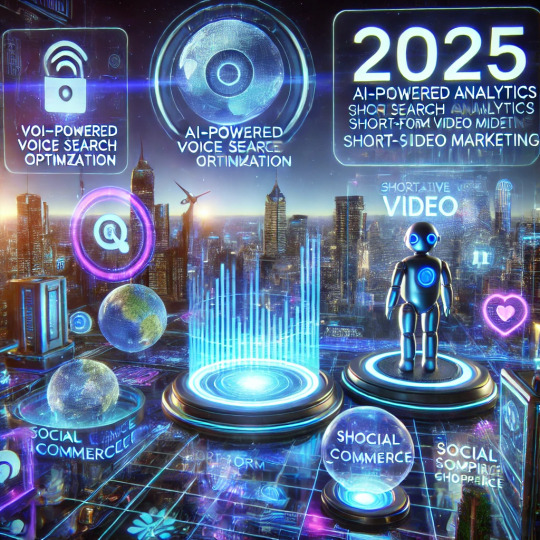
Top Digital Marketing Trends to Watch in 2025
The digital marketing landscape is rapidly evolving, and businesses that fail to adapt risk falling behind. As we move into 2025, the industry is set for transformative changes driven by technological advancements and shifts in consumer behavior. Here are the biggest trends shaping the future of digital marketing.
1. AI-Driven Personalization & Predictive Analytics
Artificial Intelligence (AI) is revolutionizing marketing strategies, offering hyper-personalized experiences based on user data and behavior. AI-driven algorithms analyze customer preferences, enabling brands to deliver tailored content, recommendations, and advertisements that boost engagement and conversions.
2. Voice Search Optimization Becomes a Must
With the increasing use of voice assistants like Alexa, Google Assistant, and Siri, optimizing content for voice search is no longer optional. Marketers need to focus on conversational keywords and natural language queries to rank higher in search engine results.
3. Short-Form Video Continues to Dominate
Platforms like TikTok, Instagram Reels, and YouTube Shorts are redefining video marketing. Consumers prefer snackable, engaging content, making short-form videos a key tool for brand storytelling and audience interaction.
4. Social Commerce Revolution
Shopping directly on social media platforms is growing rapidly. With seamless checkout integrations on Facebook, Instagram, TikTok, and Pinterest, brands can drive direct sales without customers leaving their favorite social platforms.
5. Zero-Click Searches & AI-Enhanced SEO
Google’s AI-driven search evolution is shifting focus towards zero-click searches, where users find answers directly in the search results without clicking on a website. Businesses must optimize for featured snippets, structured data, and Google’s AI-generated summaries to stay visible.
6. Influencer Marketing Gets More Niche-Specific
Consumers trust micro and nano-influencers more than traditional celebrities. Brands will invest in authentic partnerships with niche influencers to boost credibility and engagement.
7. Augmented Reality (AR) & Virtual Reality (VR) in Marketing
AR/VR experiences are becoming powerful marketing tools, allowing customers to “try before they buy” using AR filters, virtual showrooms, and interactive product demos. This enhances engagement and boosts conversion rates.
8. Ethical & Sustainable Marketing Takes Center Stage
Consumers are increasingly eco-conscious, expecting brands to demonstrate social responsibility. Transparency, ethical sourcing, and sustainability-focused messaging will be critical for gaining trust and loyalty.
9. Chatbots & Conversational AI for Instant Engagement
AI-powered chatbots and virtual assistants will become even more advanced, providing real-time customer support, personalized product recommendations, and automated lead generation without human intervention.
10. Data Privacy & First-Party Data Strategies
With third-party cookies disappearing, brands must shift to first-party data collection strategies, such as loyalty programs, interactive content, and AI-driven customer insights, to maintain effective audience targeting.
Final Thoughts
Digital marketing in 2025 is all about AI-driven automation, hyper-personalization, and immersive experiences. Businesses that embrace these trends and innovate will stay ahead in the competitive landscape. Are you ready for the future of marketing?
#DigitalMarketing2025 #MarketingTrends #AIinMarketing #SEOTrends #SocialCommerce #VoiceSearch #ShortFormVideo
0 notes
Text

A/B Testing in Digital Marketing: Making Data-Driven Decisions for Better Results
In today’s digital marketing landscape, making informed decisions is the key to maximizing engagement and conversions. A/B testing—also known as split testing—is a proven method that allows marketers to compare two versions of a webpage, ad, email, or any digital asset to determine which one performs better.
Why A/B Testing is Essential
Many businesses rely on intuition when crafting marketing campaigns, but data-driven insights ensure decisions are based on actual user behavior. A/B testing helps marketers optimize campaigns by analyzing real-time responses to different variations. Even minor changes—like adjusting a call-to-action (CTA) button color, headline text, or image—can lead to significant improvements in click-through rates (CTR) and conversions.
How to Run an Effective A/B Test
1. Set a Clear Objective – Define the metric you want to improve, such as conversion rate, email open rate, or engagement.
2. Choose One Variable to Test – Testing too many elements at once can skew results. Start with one variable, such as a headline or CTA.
3. Split Your Audience Randomly – Ensure your test groups are equal and unbiased for accurate results.
4. Run the Test for a Sufficient Duration – Give the test enough time to collect statistically significant data.
5. Analyze the Data and Apply Findings – Use tools like Google Optimize, Optimizely, or Facebook Ads Manager to interpret results and implement the winning version.
Real-World A/B Testing Success
Companies like Amazon and Netflix use continuous A/B testing to refine their user experience, resulting in higher engagement and customer satisfaction. Even a small tweak—such as changing a pricing display format—can have a major impact on sales and conversions.
Take Action with A/B Testing
By adopting a data-driven marketing approach, businesses can minimize guesswork and maximize results. Whether it’s refining landing pages, ad creatives, or email subject lines, A/B testing empowers marketers to make smarter, more effective decisions.
#DigitalMarketing #ABTesting #MarketingStrategy #DataDriven #SEO #SocialMediaMarketing #MarketingOptimization
0 notes
Text
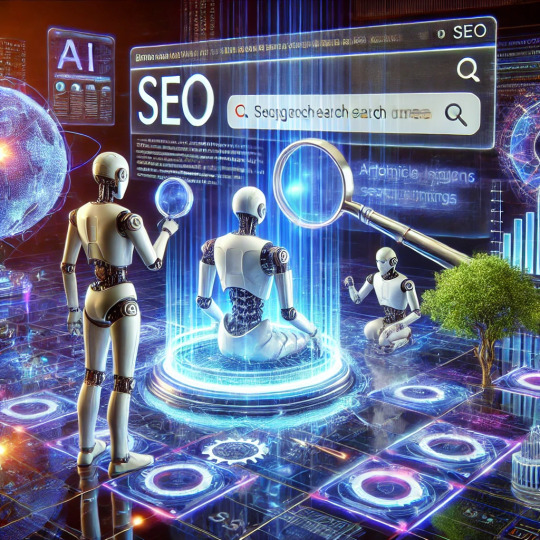
AI-Driven SEO: How Artificial Intelligence is Transforming Search Optimization
Search Engine Optimization (SEO) is no longer just about keyword density and backlinks. Artificial Intelligence (AI) has reshaped the way search engines analyze and rank content, making SEO more dynamic, intuitive, and user-focused than ever before.
How AI is Revolutionizing SEO
1. Smarter Keyword Research & Search Intent Analysis
AI-powered tools like Google’s RankBrain, Semrush, and Ahrefs don’t just analyze keywords; they understand user intent. Instead of ranking pages based solely on keyword matching, AI determines what users truly seek and delivers the most relevant content.
2. AI-Generated Content & Optimization
Platforms like Surfer SEO, Frase, and MarketMuse use AI to analyze top-performing content, offering data-driven suggestions on structure, readability, and topic relevance. AI-generated content tools, such as Jasper AI and Copy.ai, assist in creating high-quality, SEO-optimized articles.
3. Voice Search & Conversational SEO
With the rise of Alexa, Siri, and Google Assistant, voice search is changing SEO strategies. AI adapts to natural language processing (NLP), favoring conversational and long-tail keywords over traditional search queries.
4. Predictive SEO & Trend Forecasting
AI anticipates search trends before they become mainstream. Google Trends, Clearscope, and BuzzSumo analyze historical data to help marketers create content ahead of the competition.
5. Automated SEO Audits & Rank Monitoring
AI-based SEO tools can instantly scan websites, detect issues, and suggest fixes. Platforms like Screaming Frog, Sitebulb, and Google Search Console automate technical audits, backlink analysis, and on-page optimization.
The Future of AI in SEO
AI-driven SEO is shifting focus from rigid keyword strategies to user experience and engagement. To stay ahead, businesses must:
✔ Leverage AI tools for content optimization and trend analysis
✔ Prioritize high-quality, user-friendly content
✔ Adapt to voice search and conversational AI trends
As AI continues to evolve, businesses that embrace machine learning, NLP, and automation will have the competitive edge in search rankings. SEO is no longer just about search engines—it’s about delivering the best possible experience to users.
#AISEO #DigitalMarketing #SearchOptimization #SEOTrends #ArtificialIntelligence #VoiceSearch #MarketingAI #FutureOfSEO
#digital marketing#i love them smmmm#media marketing#seo company#smm panel#smm#smm2#smmagency#smmarketing#social marketing
0 notes
Text
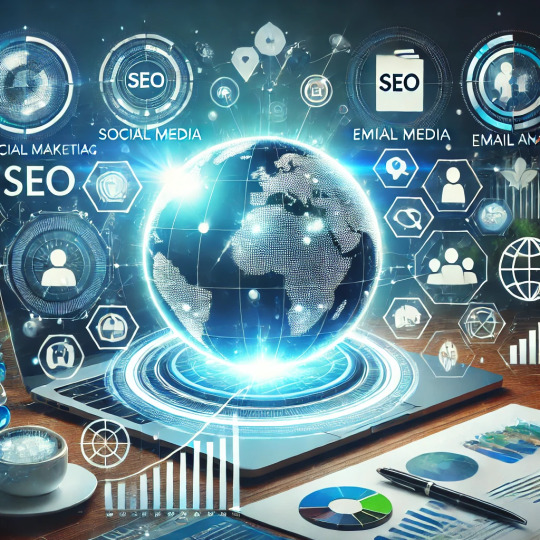
The Transformative Power of Digital Marketing. Taking Businesses to New Heights
In the fast-paced world of modern business, digital marketing has become a revolutionary force. Gone are the days when traditional advertising was the only option—today businesses leverage cutting-edge online platforms to expand their reach engage customers, and drive measurable growth. So, what makes digital marketing a must-have for businesses of all sizes?
1. Breaking Barriers with Unparalleled Reach
Digital marketing shatters geographical limitations. Whether through SEO, social media campaigns or email marketing, even small businesses can compete with industry leaders. By targeting precise audiences worldwide businesses can connect with potential customers like never before.
2. Affordable and Scalable Solutions
Traditional advertising often comes with a hefty price tag, but digital marketing offers flexible, budget-friendly options. Tools like Google Ads and social media platforms empower businesses to control their spending, optimize campaigns on the go, and focus on high-value audiences for maximum ROI.
3. Insights That Drive Decisions
One of the greatest strengths of digital marketing is its ability to generate actionable data. Tools like Google Analytics and social media insights provide a clear picture of customer behavior, campaign effectiveness, and return on investment. Businesses can make informed decisions and quickly pivot strategies to ensure every dollar counts.
4. Personalization That Builds Loyalty
With AI-powered tools, businesses can deliver tailored experiences to countless customers simultaneously. Personalized email campaigns, targeted ads, and curated recommendations foster trust, enhance engagement, and turn customers into loyal brand advocates.
5. Preparing for the Future
As technology evolves, so do consumer expectations. Digital marketing keeps businesses ahead of the curve, ensuring they remain relevant, adaptable, and ready to meet the ever-changing needs of their customers.
Let Immensity IT Empower Your Business
At Immensity IT, we specialize in creating innovative and cost-effective digital marketing strategies designed specifically for your business. From SEO and social media marketing to data-driven solutions, we’re here to help you achieve your goals.
Contact us today to discover how we can take your business to the next level!
#DigitalMarketing #SEO #SocialMediaSuccess #BusinessInnovation #GrowthWithImmensityIT
0 notes
Text
AI and Predictive Analytics: The Next Chapter in Digital Marketing.
In today’s digital marketing landscape data is king but actionable insights are the real power. Enter AI-driven predictive analytics the bridge between raw data and future-ready strategies.
Predictive analytics, powered by AI, doesn’t just analyze historical trends; it forecasts what will happen next. For marketers this opens up incredible possibilities — predicting customer behavior identifying future trends and crafting highly personalized campaigns that drive ROI.
Imagine knowing which products your customers will search for next month or identifying the precise content that will engage your audience in the next quarter. AI tools analyze vast datasets recognize patterns and provide actionable insights that were once impossible for humans to calculate in real time.
At Immensity IT we leverage AI to empower small and medium-sized businesses with tools that:
• Forecast consumer demand.
• Automate targeted marketing campaigns.
• Optimize budgets with precision-driven recommendations.
The result? Businesses that are proactive rather than reactive. In a world where customer expectations evolve rapidly, predictive AI gives you the competitive edge you need to meet them — and exceed them.
Are you ready to take your digital marketing strategies into the future? Let’s harness the power of predictive AI together.
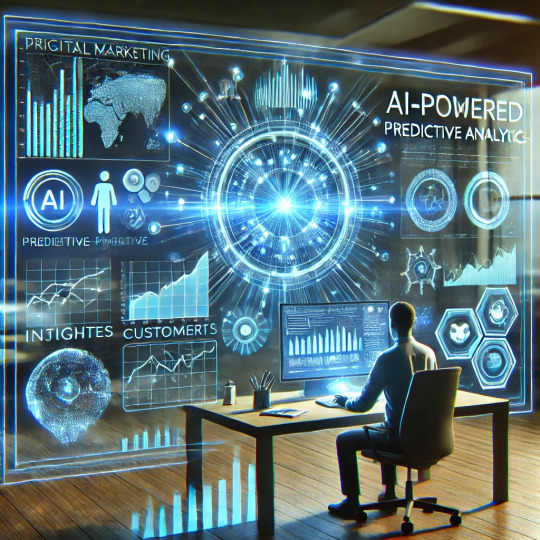
#digital marketing#i love them smmmm#media marketing#seo company#smm#smm panel#smm2#smmagency#smmarketing#social marketing
0 notes
Text

Top 5 SEO Mistakes Small Businesses Make and How to Fix Them
Small businesses often struggle with search engine optimization (SEO) due to limited resources and a lack of expertise. However, avoiding common mistakes can dramatically improve their online visibility and search rankings. Here are the top five SEO mistakes small businesses make and actionable solutions to fix them.
1. Ignoring Keyword Research
One of the biggest SEO missteps is failing to conduct thorough keyword research. Many small businesses target keywords that are too competitive or irrelevant to their audience.
Fix: Use tools like Google Keyword Planner or Ubersuggest to identify long-tail keywords that are specific to your niche and have manageable competition. Incorporate these keywords naturally into your content.
2. Poor Website Optimization
Slow-loading websites, broken links, and non-mobile-friendly designs harm both user experience and search rankings.
Fix: Regularly audit your site using tools like Google PageSpeed Insights or Screaming Frog. Optimize images, fix broken links, and ensure your website is responsive on all devices.
3. Skipping Local SEO
Many small businesses neglect local SEO, missing out on opportunities to attract nearby customers.
Fix: Claim your Google Business Profile, include accurate contact information, and encourage satisfied customers to leave reviews. Use local keywords in your content and meta descriptions.
4. Overlooking Quality Content
Publishing thin or irrelevant content often leads to poor rankings.
Fix: Focus on creating high-quality, informative, and engaging content that answers your audience’s questions. Regularly update your blog and include visuals like images or videos to enhance user experience.
5. Neglecting Analytics
Without tracking your performance, it’s impossible to identify what works and what doesn’t.
Fix: Set up Google Analytics and Google Search Console to monitor traffic, keyword performance, and user behavior. Use this data to refine your SEO strategy over time.
By addressing these common mistakes, small businesses can significantly improve their SEO efforts, attract more traffic, and compete effectively in the digital space.
#SEOForSmallBusiness #DigitalMarketingTips #LocalSEO #WebsiteOptimization #ContentStrategy #SearchRankings #MarketingMistakes #SEOInsights
0 notes
Text

The Power of SEO: Why It’s a Game-Changer for Your Business
In today’s fast-paced digital world, simply having an online presence is no longer enough. Businesses need to stand out, attract the right audience, and convert visitors into loyal customers. That’s where Search Engine Optimization (SEO) comes into play. It’s not just a marketing buzzword—it’s a strategic investment that can redefine your business’s growth trajectory.
What is SEO?
SEO is the art and science of optimizing your website to rank higher on search engine results pages (SERPs). It involves using targeted keywords, creating high-quality content, and improving technical aspects of your site to make it more visible and attractive to search engines like Google and Bing.
Why Should You Invest in SEO?
1. Unmatched Visibility
Imagine your website ranking on the first page of Google when someone searches for your product or service. SEO turns this vision into reality, ensuring that your business is seen by those who need it most. Higher visibility means more traffic, more inquiries, and ultimately, more revenue.
2. Builds Credibility and Trust
Websites that rank high in search results are often perceived as more trustworthy and authoritative. SEO helps establish this credibility by optimizing content, backlinks, and technical performance, giving your audience confidence in your brand.
3. Cost-Efficiency
Compared to paid advertising, SEO offers a cost-effective solution with long-term benefits. While pay-per-click campaigns require constant spending, SEO efforts continue to yield results over time with regular updates and maintenance.
4. Enhances User Experience
Good SEO practices go hand-in-hand with improved user experience. Optimized websites are faster, mobile-friendly, and easier to navigate—factors that search engines love and users appreciate.
5. Gives You a Competitive Edge
In a competitive market, staying ahead is essential. By investing in SEO, you not only meet your audience where they are but also outperform competitors who haven’t yet realized the value of this digital strategy.
The Future is SEO
SEO is not a one-time task—it’s an ongoing strategy that evolves with search engine algorithms and user behaviors. Businesses that prioritize SEO are better equipped to adapt to these changes and maintain their competitive edge.
So, why wait? Investing in SEO today is an investment in your brand’s tomorrow. Whether you’re a small business or a multinational corporation, SEO is the key to unlocking your full potential in the digital landscape.
#digital marketing#i love them smmmm#media marketing#seo company#smm#smm panel#smm2#smmagency#smmarketing#social marketing
0 notes